
Year 714 (DCCXIV) was a common year starting on Monday of the Julian calendar. The denomination 714 for this year has been used since the early medieval period, when the Anno Domini calendar era became the prevalent method in Europe for naming years.
The 730s decade ran from January 1, 730, to December 31, 739.
The 720s decade ran from January 1, 720, to December 31, 729.
The 710s decade ran from January 1, 710, to December 31, 719.
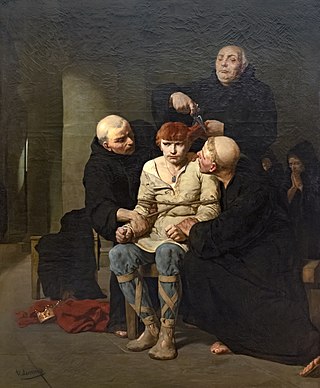
Year 737 (DCCXXXVII) was a common year starting on Tuesday of the Julian calendar. The denomination 737 for this year has been used since the early medieval period, when the Anno Domini calendar era became the prevalent method in Europe for naming.

Year 720 (DCCXX) was a leap year starting on Monday of the Julian calendar. The denomination 720 for this year has been used since the early medieval period, when the Anno Domini calendar era became the prevalent method in Europe for naming years.

Year 721 (DCCXXI) was a common year starting on Wednesday of the Julian calendar. The denomination 721 for this year has been used since the early medieval period, when the Anno Domini calendar era became the prevalent method in Europe for naming years.
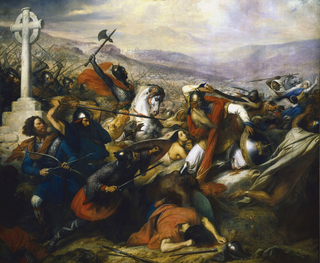
The Battle of Tours, also called the Battle of Poitiers and the Battle of the Highway of the Martyrs, was fought on 10 October 732, and was an important battle during the Umayyad invasion of Gaul. It resulted in the victory for the Frankish and Aquitanian forces, led by Charles Martel, over the invading Muslim forces of the Umayyad Caliphate, led by Abd al-Rahman al-Ghafiqi, governor of al-Andalus. Several historians, such as Edward Gibbon, have credited the Christian victory in the battle as an important factor in curtailing the Islamization of Western Europe.
Abd al-Rahman ibn Abd Allah Al-Ghafiqi, was an Arab Umayyad commander and governor who led Andalusian Muslim forces against the Franks. His invasion failed, and he was killed in action against the forces of Charles Martel in the Battle of Tours on October 10, 732 AD.

Septimania is a historical region in modern-day southern France. It referred to the western part of the Roman province of Gallia Narbonensis that passed to the control of the Visigoths in 462, when Septimania was ceded to their king, Theodoric II. During the Early Middle Ages, the region was variously known as Gallia Narbonensis, Gallia, or Narbonensis. The territory of Septimania roughly corresponds with the modern French former administrative region of Languedoc-Roussillon that merged into the new administrative region of Occitanie. In the Visigothic Kingdom, which became centred on Toledo by the end of the reign of Leovigild, Septimania was both an administrative province of the central royal government and an ecclesiastical province whose metropolitan was the Archbishop of Narbonne. Originally, the Goths may have maintained their hold on the Albigeois, but if so it was conquered by the time of Chilperic I. There is archaeological evidence that some enclaves of Visigothic population remained in Frankish Gaul, near the Septimanian border, after 507.
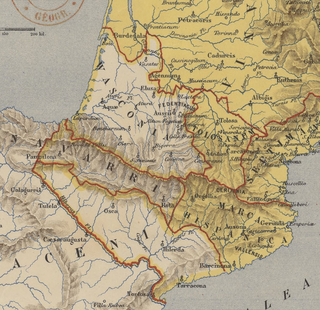
The Spanish March or Hispanic March was a military buffer zone beyond the former province of Carolingian Septimania established by Charlemagne in 795 as a defensive barrier between the Muslim-ruled Umayyad Caliphate of al-Andalus and the Frankish Carolingian Empire.
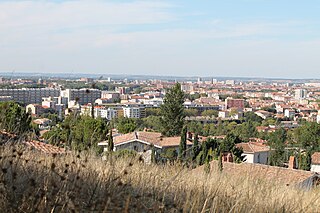
The Battle of Toulouse (721) was a victory of an Aquitanian Christian army led by Odo the Great, Duke of Aquitaine over an Umayyad Muslim army besieging the city of Toulouse, led by al-Samh ibn Malik al-Khawlani, the Umayyad wāli (governor-general) of al-Andalus. The decisive Aquitanian victory checked the spread of Umayyad control westward from Narbonne into Aquitaine.
Odo the Great, was the Duke of Aquitaine by 700. His territory included Vasconia in the south-west of Gaul and the Duchy of Aquitaine, a realm extending from the Loire to the Pyrenees, with the capital in Toulouse. He fought the Carolingian Franks and made alliances with the Moors to combat them. He retained this domain until 735. He is remembered for defeating the Umayyads in 721 in the Battle of Toulouse. He was the first to defeat them decisively in Western Europe. The feat earned him the epithet "the Great". He also played a crucial role in the Battle of Tours, working closely with Charles Martel, whose alliance he sought after the Umayyad invasion of what is now southern France in 732.
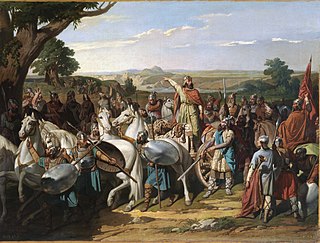
The Muslim conquest of the Iberian Peninsula by the Umayyad Caliphate occurred between approximately 710 and the 720s. The conquest resulted in the defeat of the Visigothic Kingdom and the establishment of the Umayyad Wilayah of Al-Andalus.
Al-Samh ibn Malik al-Khawlani was the Arab governor general of Al-Andalus from between 719 and 721. In 720, under his governorate he minted the first purely Arab coins in Al-Andalus as part of his fiscal reforms.

The siege of Avignon was contested in 737. Frankish forces led by Charles Martel defeated the Umayyad garrison of Avignon and destroyed the stronghold.
The Battle of the River Berre was fought in 737 between the Arab and Berber Muslim forces of Yusuf ibn Abd al-Rahman al-Fihri, Arab Umayyad Muslim governor of Septimania on behalf of al-Andalus, and the Frankish Christian army led by the Carolingian duke Charles Martel during the siege of Narbonne. The battle, which took place at the mouth of the River Berre, was a significant victory for Charles Martel in the military campaigns of 736–737. During this period, Martel effectively prevented greater Umayyad expansion beyond the Pyrénées.
Septimania was the western region of the Roman province of Gallia Narbonensis that passed under the control of the Visigoths in 462. It passed briefly to the Emirate of Córdoba in the eighth century before its reconquest by the Franks, who by the end of the ninth century termed it Gothia. This article presents a timeline of its history.

The Umayyad invasion of Gaul occurred in two phases in 719 and 732 AD. Although the Umayyads secured control of Septimania, their incursions beyond this into the Loire and Rhône valleys failed. By 759 Muslim forces had lost Septimania to the Christian Franks and retreated to Iberia.

The siege of Narbonne took place in France between 752 and 759, led by the Frankish king Pepin the Short against the Umayyad stronghold defended by an garrison of Arab and Berber Muslim troops who had invaded Septimania and occupied the Visigothic Kingdom and its Gallo-Roman inhabitants since 719. The siege remained as a key battlefield in the context of the Carolingian expedition south to Provence and Septimania starting in 752.











